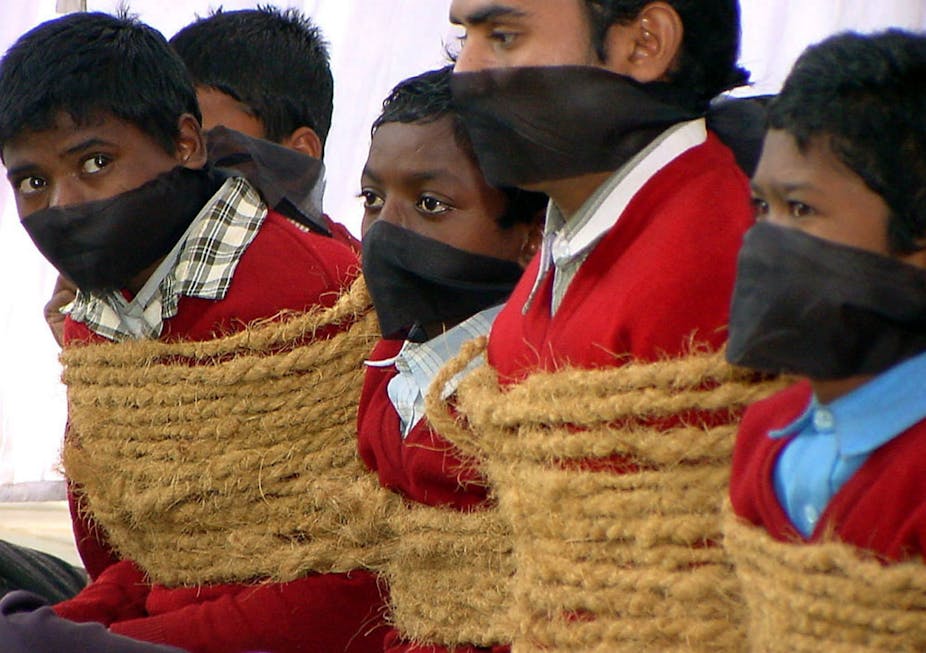In the late 18th century, a small band of British Quakers and other humanitarian-minded folk began to build the case against the slave trade. Britain’s supremacy in maritime power and technology meant that it led the world in the transatlantic trade in African “cargo”, having overtaken Portuguese, Spanish and French competitors.
Gruesome evidence, given by ship captains, sailors and former slave trade surgeons, was presented to British parliament in the 1780s and circulated widely in the burgeoning print media. The public learnt for the first time the details of their nation’s blood-soaked trade.
Revulsion and guilt were widespread. A boycott movement got underway, urging people to reject sugar in their coffee and tea. To persist in the consumption of West Indian sugar was (it was argued) tantamount to ingesting the blood, sweat and tears of suffering plantation workers.
Partly as a result of the continued high visibility of slavery’s atrocities, the slave trade was abolished in Britain in 1807. Particularly affecting, in terms of emotional impact, was the focus on the kidnapping of children and the separation of family members on the auction block. Similar emotional triggers operate today in spurring members of the public into action.
Forrest takes up an old fight
The sexual slavery of a deeply traumatised girl from Kathmandu, sent to the Middle East at the age of nine and discarded at 12, was the trigger for mining billionaire Andrew Forrest to establish his Walk Free Foundation in 2010.
This global activist movement attracted the support of heavy-hitting politicians and philanthropists such as the Clintons, Tony Blair and Bill Gates. Now this foundation has spawned the Global Freedom Network, an organisation that aims to free the world’s estimated 30 million slaves.

With an eye to high-level visibility and media impact, Forrest has headed up this network with three leaders of world religions: the Pope, the Archbishop of Canterbury and the Grand Imam of al-Azhar in Egypt. This is a remarkable clutch of high-profile collaborators.
Associated with the Global Freedom Network is the Global Slavery Index, launched last year. This lists countries where slavery is most prevalent, in ranked order. Improvements in the index for 2014 will be achieved (it is promised) by determining rankings according to a combined measure of “prevalence” and “government response”.
Forrest is adamant that his work against modern-day slavery is not an exercise in “feel-good” philanthropy, which will evaporate as soon as the media turns its attention elsewhere.
Forrest vows to draw upon all the hard-edged business skills that have generated his immense wealth to date. For instance, he has already brokered a deal under which Australian technology for coal conversion will be given pro bono to Pakistan in exchange for government-led efforts to eradicate slavery in the Punjab.
Supply chains make us complicit
Supply chains will be a particular focus of the Global Freedom Network. Government leaders and corporate CEOs will also be urged to make visible and “slavery-proof” the often unseen links between the source and the finished product sold on the high street.
Last year’s deadly garment-factory collapse in Savar, Bangladesh, which killed 1129 workers and injured 2515, triggered widespread discussions about corporate social responsibility across global supply chains. It also brought home the extent to which we consumers in the wealthy West are complicit in modern slavery.
Given the scale of this tragedy, the response from Western businesses has been less than impressive. Of the 29 brands identified as having sourced products from the collapsed Savar building, only nine attended meetings held late last year to agree on a minimum wage for garment workers and compensation for the garment trade’s victims.
The definition of modern slavery covers many forms. It includes people trafficking, sexual slavery, child labour, forced marriage, debt bondage, hereditary slavery and a rapidly expanding trade in organs and transnational surrogacy.
Forrest’s ambition is enormous – a dream some might say. Nor is his aspiration new in any way. As we have seen, he takes his inspiration from those first abolitionist movements of the late 18th century.
More recently he has taken his cue from the excellent work of Kevin Bales and his “Free the Slaves” movement. Forrest’s Global Slavery Index declares that it is indebted to Bales’ work over the last 15 years. This has resulted in many books, including the powerful Disposable People: New Slavery in the Global Economy (1999), a study of five slave-based businesses.
Depressing as Bales’ case studies might be, he nevertheless conveys an upbeat message. This can be seen in his TED talk of 2010 where he argues that the percentage of people enslaved today is less than hitherto, as is the wealth generated by slaves globally.
Ironically, the explosion of the world’s population, which means that people are so cheap — much cheaper than in the 18th century – also means that it is now possible for us to buy them out of slavery.

